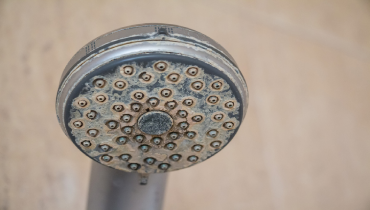
If you’ve looked up at your showerhead and seen mold, mildew, or other types of build-up, you may wonder why this is happening. After all, water comes out of the showerhead, so it shouldn’t be able to grow anything there, right? Wrong.
Showerheads can actually be a breeding ground for mold and mildew if they’re not cleaned regularly. Our team at Mr. Rooter Plumbing of Memphis can explain why your showerhead might be moldy and how you can keep it from growing red, black, or green mold.
Reasons Showerheads Get Moldy
The red mold that appears on showerheads is a common frustration for homeowners. There are several reasons why a showerhead is susceptible to this form of growth, including:
- Humidity and moisture, which can increase in the environment surrounding the showerhead with regular hot water use
- Improper ventilation, creating a hospitable climate for mold to thrive
- Water droplets left behind on the surface of the showerhead allows bacteria to adhere and then multiply quickly
The best way to avoid red or black mold buildup is to ensure your bathroom is properly ventilated and surfaces are cleaned often, especially around the showerhead.
Mold Can Cause Health Issues
Mold is a serious health concern and can cause dirty Showerhead disease or nontuberculous mycobacterial (NTM) lung infection, as well as other health problems. Mold lurks all around us, growing in damp or wet areas (like bathrooms and unfinished basements) and releasing spores that can lead to a lot of potential troubles.
Dirty Showerhead disease is caused by mold growing within the Showerhead and releasing mycobacterium avium into the air when showering. Symptoms could include difficulty breathing, coughing, chest pain and fever. It’s important to be proactive in identifying and addressing any moldy areas around your shower before it has a chance to cause major damage to fixtures and your health. Taking preventative measures like buying an antimicrobial Showerhead will help ensure that you have clean air while taking showers.
How to Thoroughly Disinfect a Showerhead
That buildup in your Showerhead is not very pleasant to look at, and it could cause some health problems when left unattended. It’s time to take charge and get that Showerhead squeaky clean! Disinfecting your showerhead is easy and can be done by following the steps below:
- Step 1: The first step is to unscrew the showerhead and soak it for up to an hour in a combination of equal parts water and white vinegar. Be sure to swish the solution around occasionally as it works its magic.
- Step 2: After an hour, rinse off all of the vinegar mixture, scrub off any residue with an old toothbrush, then replace the showerhead.
- Step 3: If you want a little extra disinfectant juice, use a cotton ball soaked in rubbing alcohol to wipe down the inside of the attachment. Then, follow the same routine: rinse and reinstall before enjoying a thoroughly disinfected Showerhead!
How Often Should I Clean My Showerhead?
Did you know that the average person spends about 8-10 minutes in the shower daily? You expect your Showerhead to last, so it’s important to consider maintenance beyond just turning on the hot water.
Cleaning your Showerhead at least once a month helps prevent bacteria and other contaminants from accumulating and keeps your shower in tip-top shape. It also helps reduce clogging and keeps your water pressure at an optimal level. Don’t worry – cleaning doesn’t have to involve harsh chemicals or extensive scrubbing. All you need is a brush or sponge, some mild detergent or white vinegar, and a few minutes of effort each month! That way, you can enjoy a sparkling clean shower experience every time.
How Can Mold Damage My Shower
Left untreated, mold can become a serious problem for your shower. Mold doesn’t just look unsightly, it can also damage your Showerhead and shower pan. Red mold growing on showerheads indicates a potential issue with plumbing and hard water. This type of damage due to mold buildup can lead to costly repairs, not to mention the potential health hazards associated with shower mold and mildew growth. The best way to protect against these issues is by cleaning frequently and drying completely after use. Regular cleaning will help guarantee that your showerhead and plumbing remain in great condition while preventing any kind of unwanted buildup from taking hold.
Let Mr. Rooter Plumbing of Memphis Support You With Plumbing Maintenance
If you see mold or mildew on your showerhead, it’s important to clean it as soon as possible. Not only can mold cause health problems, but it can also damage your shower. You should aim to clean your showerhead at least once a month, but more often if you live in an area with hard water.
When dealing with plumbing issues from hard water, mold, lack of maintenance, etc., Mr. Rooter Plumbing of Memphis is ready to help!
Request service online or call us for more information.

